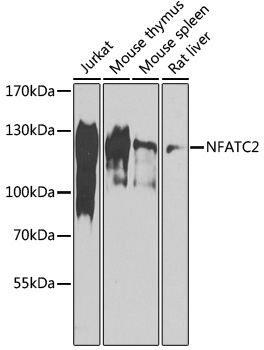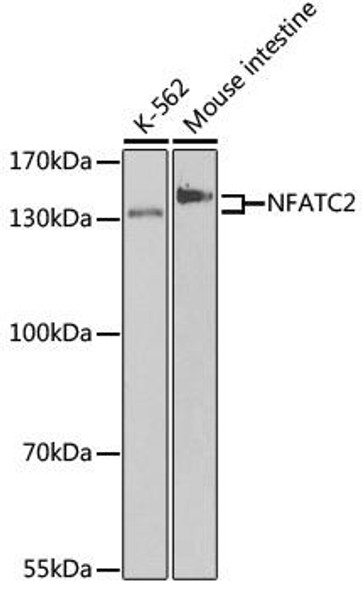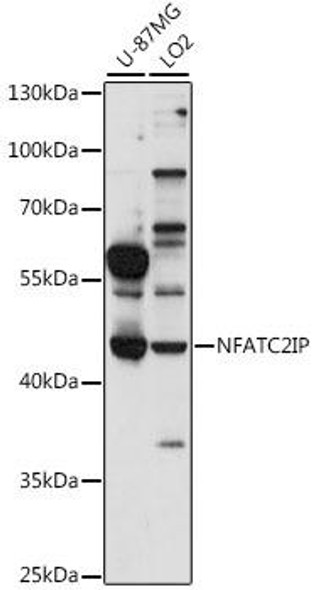Anti-NFATC2 Antibody (CAB14189)
- SKU:
- CAB14189
- Product type:
- Antibody
- Reactivity:
- Human
- Mouse
- Rat
- Host Species:
- Rabbit
- Isotype:
- IgG
- Antibody Type:
- Polyclonal Antibody
- Research Area:
- Epigenetics and Nuclear Signaling
Description
| Antibody Name: | Anti-NFATC2 Antibody |
| Antibody SKU: | CAB14189 |
| Antibody Size: | 20uL, 50uL, 100uL |
| Application: | WB |
| Reactivity: | Human, Mouse, Rat |
| Host Species: | Rabbit |
| Immunogen: | Recombinant fusion protein containing a sequence corresponding to amino acids 1-300 of human NFATC2 (NP_775114.1). |
| Application: | WB |
| Recommended Dilution: | WB 1:500 - 1:2000 |
| Reactivity: | Human, Mouse, Rat |
| Positive Samples: | Jurkat, mouse thymus, mouse spleen, rat liver |
| Immunogen: | Recombinant fusion protein containing a sequence corresponding to amino acids 1-300 of human NFATC2 (NP_775114.1). |
| Purification Method: | Affinity purification |
| Storage Buffer: | Store at -20°C. Avoid freeze / thaw cycles. Buffer: PBS with 0.02% sodium azide, 50% glycerol, pH7.3. |
| Isotype: | IgG |
| Sequence: | MNAP ERQP QPDG GDAP GHEP GGSP QDEL DFSI LFDY EYLN PNEE EPNA HKVA SPPS GPAY PDDV LDYG LKPY SPLA SLSG EPPG RFGE PDRV GPQK FLSA AKPA GASG LSPR IEIT PSHE LIQA VGPL RMRD AGLL VEQP PLAG VAAS PRFT LPVP GFEG YREP LCLS PASS GSSA SFIS DTFS PYTS PCVS PNNG GPDD LCPQ FQNI PAHY SPRT SPIM SPRT SLAE DSCL GRHS PVPR PASR SSSP GAKR RHSC AEAL VALP PGAS PQRS RSPS PQPS SHVA PQDH GSPA GYPP VAGS |
| Gene ID: | 4773 |
| Uniprot: | Q13469 |
| Cellular Location: | Cytoplasm, Nucleus |
| Calculated MW: | 76kDa/97kDa/98kDa/99kDa/100kDa |
| Observed MW: | 130kDa |
| Synonyms: | NFATC2, NFAT1, NFATP |
| Background: | This gene is a member of the nuclear factor of activated T cells (NFAT) family. The product of this gene is a DNA-binding protein with a REL-homology region (RHR) and an NFAT-homology region (NHR). This protein is present in the cytosol and only translocates to the nucleus upon T cell receptor (TCR) stimulation, where it becomes a member of the nuclear factors of activated T cells transcription complex. This complex plays a central role in inducing gene transcription during the immune response. Alternate transcriptional splice variants encoding different isoforms have been characterized. |
| UniProt Protein Function: | NFAT1: a transcription factor that plays a role in the inducible expression of cytokine genes in T cells, especially in the induction of the IL-2, IL-3, IL-4, TNF-alpha and GM-CSF. It is present in a phosphorylated the cytosol of unstimulated T cells. After T-cell activation, it is dephosphorylated by calcineurin and translocates to the nucleus as a part of a transcription complex. Two splice variant isoforms have been identified. |
| UniProt Protein Details: | Protein type:DNA-binding; Transcription factor Chromosomal Location of Human Ortholog: 20q13.2 Cellular Component: nucleoplasm; cytoplasm; plasma membrane; ribonucleoprotein complex; nucleus; cytosol; actin cytoskeleton Molecular Function:protein binding; DNA binding; transcription factor activity Biological Process: response to drug; B cell receptor signaling pathway; cell migration; transcription, DNA-dependent; regulation of transcription, DNA-dependent; positive regulation of transcription, DNA-dependent; positive regulation of B cell proliferation; cytokine production; innate immune response; positive regulation of transcription from RNA polymerase II promoter; negative regulation of transcription from RNA polymerase II promoter; response to DNA damage stimulus |
| NCBI Summary: | This gene is a member of the nuclear factor of activated T cells (NFAT) family. The product of this gene is a DNA-binding protein with a REL-homology region (RHR) and an NFAT-homology region (NHR). This protein is present in the cytosol and only translocates to the nucleus upon T cell receptor (TCR) stimulation, where it becomes a member of the nuclear factors of activated T cells transcription complex. This complex plays a central role in inducing gene transcription during the immune response. Alternate transcriptional splice variants encoding different isoforms have been characterized. [provided by RefSeq, Apr 2012] |
| UniProt Code: | Q13469 |
| NCBI GenInfo Identifier: | 68846905 |
| NCBI Gene ID: | 4773 |
| NCBI Accession: | Q13469.2 |
| UniProt Secondary Accession: | Q13469,Q13468, Q5TFW7, Q5TFW8, Q9NPX6, Q9NQH3, Q9UJR2 B5B2N8, B5B2N9, B5B2P0, B5B2P2, B5B2P3, |
| UniProt Related Accession: | Q13469 |
| Molecular Weight: | 901 |
| NCBI Full Name: | Nuclear factor of activated T-cells, cytoplasmic 2 |
| NCBI Synonym Full Names: | nuclear factor of activated T-cells, cytoplasmic, calcineurin-dependent 2 |
| NCBI Official Symbol: | NFATC2 |
| NCBI Official Synonym Symbols: | NFAT1; NFATP |
| NCBI Protein Information: | nuclear factor of activated T-cells, cytoplasmic 2; NF-ATc2; NFAT pre-existing subunit; T cell transcription factor NFAT1; T-cell transcription factor NFAT1; NFAT transcription complex, preexisting component; preexisting nuclear factor of activated T-cells 2; nuclear factor of activated T-cells, preexisting component |
| UniProt Protein Name: | Nuclear factor of activated T-cells, cytoplasmic 2 |
| UniProt Synonym Protein Names: | NFAT pre-existing subunit; NF-ATp; T-cell transcription factor NFAT1 |
| Protein Family: | NFATC2-interacting protein |
| UniProt Gene Name: | NFATC2 |
| UniProt Entry Name: | NFAC2_HUMAN |




